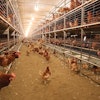This July, the American Society of Animal Science and the Poultry Science Association turn their attention to two research trials on the CALICA+ feed additive launched by Ceresco Nutrition. During the ASAS Annual Meeting and the PSA Annual meeting, Dr. Carl Julien, from the CRSAD research center (Deschambault, Quebec, Canada) will be talking about the anticoccidial and growth performance effects of the organic feed additive in comparison to nicarbazin and monensin treatments.
Current conditions in Canada has poultry producers actively seeking out new natural and effective products for preventing coccidiosis. Drugs alternatives are needed for the poultry industry not only for organic production but also for limiting drug resistance and for complying with upcoming regulations and consumer demands.
Ceresco Nutrition, known for its activated feed additive SILICA+, has taken up the challenge and responded to the demand of the poultry producers. The company developed a new product based on an activated phenolic compound derived from cashew nut shell liquid (CNSL) that acts as a natural ionophore.
“The CNSL has already been known for its beneficial anti-inflammatory and antibacterial actions because of its active ingredients cardol and cardanol,” explained Luigi Pomponi, the president of Ceresco Nutrition. “The breakthrough of CALICA+ is mixing this natural vegetable oil with a blend of compatible yeast and informing the complex with our proprietary electromagnetic frequency technology, making it more available for reaction. After developing the perfect blend, we approached reputable Deschambault Research Center (CRSAD) to conduct broiler trials with various coccidia challenges. The results have been accepted to be presented at the ASAS Annual Meeting and another at the PSA Annual meeting in July 2019.”
The head of the CALICA+ trials at the CRSAD, Dr. Carl Julien explained that in the first pen trial on broiler chickens a double dose of the commercial Coccivac-B52 vaccine was used to inoculate the trial group. The goal of the second trial was then to increase the challenge by harvesting a mix of Eimeria species from the field. Hence, 200 000 sporulated oocysts were orally administered to each bird. The first and the second trials were conducted on 1800 and 1760 male birds respectively. In the first trial ADG was improved by +4.5% in CALICA+ group in comparison with the untreated group showing similar performance as the nicarbazin-monensin group. The second trial showed improved ADG by +4.3% compared with untreated group and showed similar ADG compared with the nicarbazin-monensin group. Overall, CALICA+ seemed to have a comparable effect as the ionophore treatment groups.
“In summary, Calica+ showed beneficial growth performance and anticoccidial effects in these two different triаl conditions, concluded Dr. Carl Julien. “This feed additive could be involved in a strategy to reduce the use of anticoccidial medication in broiler production.”

















